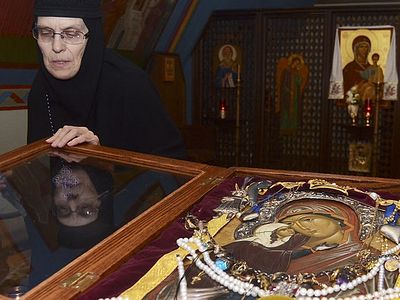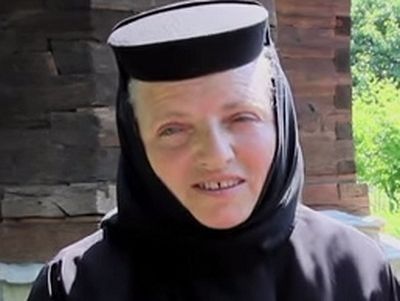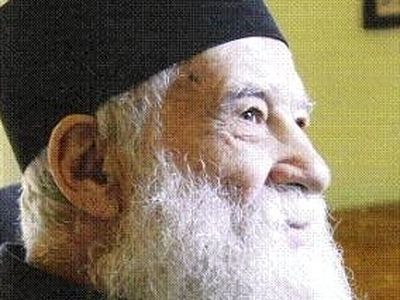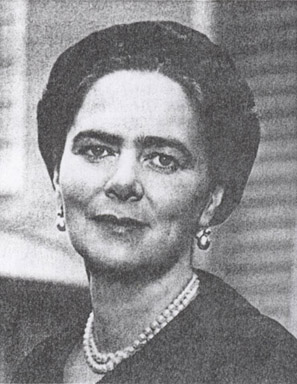 The unmistakable royal mien of Princess Ileana. Photo taken at the Vatra in 1960.
The unmistakable royal mien of Princess Ileana. Photo taken at the Vatra in 1960.
Today is the repose day of Romania’s beloved Princess, and America’s beloved abbess, Mother Alexandra (Hapsburg). In her honor we reproduce here an article publishsed a day after her repose by the Romanian American Heritage Center Information Bulletin, Vol. IX, No. 1 (Jackson Michigan, Jan-Feb 1992) and posted at Tom’s Place.
On January 21, 1991, surrounded by her worldly and spiritual family, Mother Alexandra quietly passed away at the age of 82 following a heart attack.
Though she lived in many countries and was married for many years to a non-Romanian, she remained Romanian at heart and in her spirit. Her love for her Romanian heritage came out forcefully in later years, and she found peace and serenity after an eventful and hectic life, embracing the monastic vows and totally dedicating herself to the Orthodox faith, which had nourished and strengthened her ail along. She had always been deeply religious.
She was born January 5, 1909 as the youngest child of King Ferdinand and Queen Marie of Romania,1 a Princess whose birth in a royal palace was proclaimed with a 21-gun salute thundering over the capital. Her beauty, charm, and eagerness to meet with the people as a young princess made her the darling of the Romanian people. That love affair between her and the Romanian people will never wane, and will last till the end of her life.
At 22 she married Archduke Anton of Austria. The couple set up home in Sonnberg Castle near Vienna, and in the next 10 years they would be blessed with six children. Each time one of her children was born, she had a pottery bowl of Romanian earth put under her bed so she could claim that her children were born on Romanian soil. While she raised her children in the Roman Catholic faith of her husband and of the country, she herself never abandoned her Orthodox faith. As the years passed, her faith would become stronger until it became central to her life.
When the Russian armies advanced on Vienna during World War II, she took her children to relative safety in Romania. The Bran Castle, which she inherited from her mother, Queen Marie, would become the family's temporary home for the next four years.
There, she continued doing what she had done at Sonnberg, founding a hospital and caring for the sick and wounded. With Russian troops in the country and the Communists getting a strangle-hold on the country, her life was in constant danger. As the most beloved daughter of the royal family of Romania, she was a symbol of hope and strength for the Romanian people.
When the Communists forcefully exiled King Michael in December of 1947, Princess Ileana and her family were exiled as well. Switzerland declined to give them political asylum and the family ended up with much hope in a new future in Argentina.
Unfortunately, conditions in Peron's Argentina, fraught with cheating and corruption, were worse than it had been in Europe.
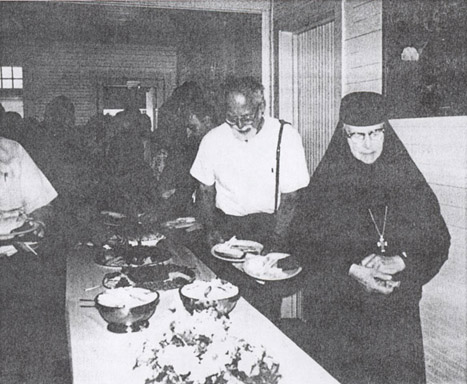 Stefan Habsburg carries the luncheon plate of his Mother at the Center's rededication luncheon July 4, 1988.
Stefan Habsburg carries the luncheon plate of his Mother at the Center's rededication luncheon July 4, 1988.
In 1950, Princess Ileana was struck down with arthritis and she received permission to come to the United States for medical treatment. By then, her marriage to Archduke Anton of Austria was on the rocks, and she arrived in the United States with her children, $300.00, and wrapped in a nightgown, the by-now famous tiara with a sapphire as big as a man's pocket watch which Tsar Nicholas of Russia had had made for his Empress when he was crowned and which Queen Marie had inherited and had given to Princess Ileana when she married the Archduke. The story of the pawning and later sale of that tiara so she can buy a house in the lovely New England countryside near Boston and feed her children was told throughout the world. She had once been addressed as Her Imperial and Royal Highness, the Most Illustrious Archduchess and Lady; now the milkboy banged on her door and yelled "Mrs. Habsburg!"
She needed to work to maintain herself and her family. The work she found was unexpected. In the fall of 1950 she was asked by the Boston Institute of Management to give a lecture. She chose as her subject "Communism and Christianity," and she was paid $25.00 for it! It was the beginning of a completely new career, and eventually she was given the crucial test that awaits all public lecturers in America—she was invited to address a gathering at the New York Town Hall. She came through with flying colors and began touring as a lecturer throughout the country, traveling up to 60,000 miles a year lecturing.
As a public speaker for eleven years, she spoke throughout the country about the sufferings of the Romanian people under Communism. Deeply religious, she was also a favorite speaker at religious gatherings.
In the '50s, Princess Ileana's love for her Church and heritage found an outlet in a cooperation with the Episcopate and with the Solia. She began writing religious articles for the Solia and to teach at the Religious Education courses at the Vatra. This cooperation with the Episcopate and the Solia will last for many years for the spiritual enrichment of both. Princess Ileana also lent her support to the Episcopate's fight for independence from the Red-dominated Bucharest Patriarchate, and stood at the Bishop's side when the attacks against him intensified in the '60s.
The transformation of Princess to Nun was gradual and did not come overnight as a result of a revelation. It was gradual, and in some respect painful, as the process to extricate herself from a married as well as from a very active social life took several years.
Princess Ileana was of a deeply religious nature. One has only to read the booklets she published prior to becoming a nun to realize that she was consumed by her Orthodox Faith: "Our Father," "The Symbol of Faith," which were meditations on the Nicene Creed, "The Spirit of the Eastern Orthodox Church," and "My Inner Faith." Later, as a Nun, she successfully tackled the very difficult subject of "The Holy Angels."
In 1957, Princess Ileana underwent a very difficult operation, which would keep her bedridden for weeks. It was during this time that the need to change her life to one dedicated to prayer and to the Church made itself felt very strongly. She struggled with this need in silence for an entire year. Finally, in the fall of '58 she shared her desire for solitude and prayer with her husband but took no active steps in that direction.
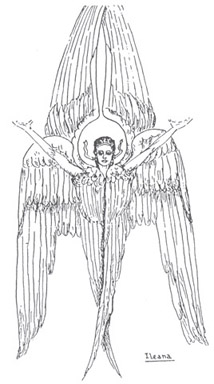 Princess Ileana's religious convictions came true in this pen and ink drawing of an angel, whose wings soar towards heaven as did her faith.
Princess Ileana's religious convictions came true in this pen and ink drawing of an angel, whose wings soar towards heaven as did her faith.
At the beginning of her postulancy in the Bussy-en-Othe monastery in France, the new Postulante Ileana wrote to a friend who wondered about her ability to retreat from a world in which she was such an active spokesperson in behalf of her suffering countrymen under Communism: "As far as my country and my countrymen are concerned, all that trespasses on my life of prayer has been gradually cut out, but I remain in the service of their and my Church. Our Faith and nation are so closely linked as to be one. I was born to a position of responsibility and leadership, and it is both in the Orthodox and Royal tradition that one of my station should in days of stress enter monastic life and pray with and for them." For several years prior and even at the beginning of her monastic life, Princess Ileana would send the Word of God and daily meditations that were transmitted via Radio Free Europe to her countrymen in Romania. For many listeners it would be the only Word of God they would receive in those times.
Her children were fully supportive of her desire to dedicate herself to a life of prayer and meditation. They could see her devotion to the Church and the visible joy she was experiencing in her new life. One thing her new life could not change though. The new habit she would wear henceforth and the various religious titles she would earn (postulante, novice, sister, mother, etc.) did not change the fact of her royal ancestry. Officially, her passport will continue to be issued to "Princess Ileana of Romania," profession: "monastic."
The thought of founding a monastery appears in Princess Ileana's writings as early as 1961, and will blossom in 1964 after taking the vows of an Orthodox nun. The Princess approached most hierarchs of the various Orthodox jurisdictions with the idea of starting an American Orthodox convent in the United States. Besides some verbal support for the idea, the implementation of it was ultimately left to the Romanian Orthodox Episcopate and its parishes, particularly those in the area in which the convent would ultimately be located. The advice and active organizational support of Bishop Valerian would be invaluable to Sister Ileana in her quest to establish the convent.
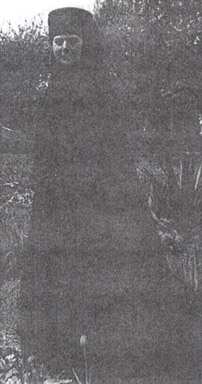 Sister Ileana in 1967, at Bussy-en-Othe Monastery in France, when she was professed a nun.
Sister Ileana in 1967, at Bussy-en-Othe Monastery in France, when she was professed a nun.
From the very beginning, Mother Alexandra would be the heart and soul and the driving motor which carried the project of the monastery from its inception to its completion. Most of the money to purchase the property in Ellwood City and to build the monastery came from Mother Alexandra's (Sister Ileana's at that time) own pockets. She believed in backing up her dream with her own resources, limited as they were.
And a dream come true it was. In an interview with a reporter from The Pittsburgh Press, she stated that, "When I lived in Austria and my children were small, I dreamed of building a monastery in a glorious place in the mountains to later retire to it, but the war made it impossible" she said. Her dream was now coming true, but in the foothills of Pennsylvania instead of the mountains of Austria.
Slowly, through Mother Alexandra's relentless efforts, the Monastery of the Transfiguration took shape and began functioning as a religious institution. A year after its founding, in September of 1968, the chapel of the monastery was consecrated by His Beatitude, Metropolitan Iriney, and six months later, Mother Alexandra was appointed Mother Superior of the Monastery and invested as such by His Grace, Bishop Valerian on March 25, 1969.
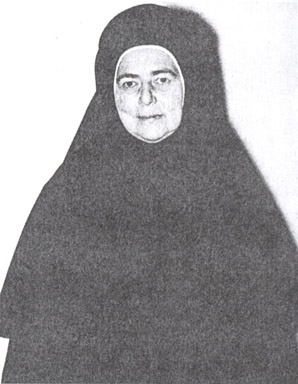 Believing that the habit worn by the nuns at Bussy-en-Othe was a bit too severe for America, Abbess Alexandra designed the above more modern habit for the nuns of the Monastery of the Transfiguration.
Believing that the habit worn by the nuns at Bussy-en-Othe was a bit too severe for America, Abbess Alexandra designed the above more modern habit for the nuns of the Monastery of the Transfiguration.
Building the community of nuns which the Monastery of the Transfiguration is today was not an easy task to accomplish. Postulants would come and go and at times she felt all alone, but she did not give up. Today, the Monastery of the Transfiguration is a viable, first of its kind institution, an all-American, English-speaking monastery in the United States, a part of the Orthodox Church in America and under the canonical obedience to Bishop Nathaniel, a religious institution in which any and all ethnic groups may feel at home.
Princess Ileana dedicated the last 30 years of her life to her Church, a dedication in which she found the, peace of mind she had been seeking. But they had also been physically stressful years, conquered only by her indomitable spirit to overcome physical pain and adversities. However, in July of 1981, because of ill health and failing strength, she most humbly requested Archbishop Valerian to release her from the responsibilities incumbent upon the Office of Abbess.
In an interview published in The Ellwood City Ledger, Grace Rischell described Mother Alexandra as "a woman with definitive ideas. In an age of situational and relative morality, she has something people don't mention much anymore: character. Her concepts about what is right or wrong are clear and steadfast." I found this to be a most accurate description of Mother Alexandra.
When she became Sister Ileana the title "Princess" became a thing of the past, but only for the profession she had embraced. The true-blue, royal blood of a great-granddaughter of Queen Victoria could not be changed by the new habit she wore, nor did our people think otherwise. For them, she continued, and continues to be a Domnitza, a Royal lady with capital letters.
May her memory be eternal.
* * *
Originally published in Romanian American Heritage Center Information Bulletin, Jan-Feb 1992, Vol. IX, No. 1.

